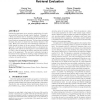430 search results - page 5 / 86 » Power of peripheral designers: how users learn to design |
SIGIR
2010
ACM
13 years 11 months ago
2010
ACM
Interleaving experiments are an attractive methodology for evaluating retrieval functions through implicit feedback. Designed as a blind and unbiased test for eliciting a preferen...
ECSCW
2003
13 years 8 months ago
2003
‘Knowledge sharing’ and ‘learning’ are terms often connected with the ‘New office’, the “modern” open office space. Work in these settings becomes more and more dis...
CHI
2010
ACM
14 years 2 months ago
2010
ACM
Human-computer systems intended for time-critical multitasking need to be designed with an understanding of how humans can coordinate and interleave perceptual, memory, and motor ...
IPSN
2005
Springer
14 years 29 days ago
2005
Springer
— This paper describes the XYZ, a new open-source sensing platform specifically designed to support our experimental research in mobile sensor networks. The XYZ node is designed...
CHI
2007
ACM
14 years 7 months ago
2007
ACM
New forms of tangible and spatial child computer interaction and supporting technologies can be designed to leverage the way children develop intelligence in the world. In order t...

